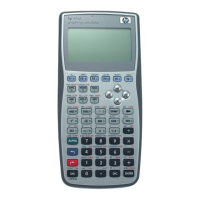4-64 Computer Algebra Commands
row reduction is done without reducing the last column, but the last column will be modified
by the reduction of the rest of the matrix.
Example: Reduce to row-reduced echelon form, modulo 3, the matrix:
2 1
3 4
Command:
rref[[2,1][3,4]]
Result: [[-1,0][0,1]]
See also: rref
SERIES
Type: Command
Description: For a given function, computes Taylor series, asymptotic development and limit at finite or
infinite points.
Access: Calculus, P
CALC, or Limits and series, !Ö LIMITS & SERIES
Input: Level 3/Argument 1: The function f(x)
Level 2/Argument 2: The variable if the limit point is 0, or an equation x = a if the limit point
is a. If the function is in terms of the current variable, this can be given as just the value a.
Level 1/Argument 3: The order for the series expansion. The minimum value is 2, and the
maximum value is 20.
Output: Level 2/Item 1: A list containing the limit as a value and as the equivalent expression, an
expression approximating the function near the limit point, and the order of the remainder.
These are expressed in terms of a small parameter h.
Level 1/Item 2: An expression for h in terms of the original variable.
Flags: Exact mode must be set (flag –105 clear).
Numeric mode must not be set (flag -3 clear).
Radians mode must be set (flag –17 set).
Example: Obtain the second order Taylor series expansion of ln(x) at x=1.
Command:
SERIES(LN(X),1,2)
Result: {{Limit: 0, Equiv: h, Expans: -1/2*h^2+h, Remain: h^3}, h=X- 1}
See also: TAYLOR0
SEVAL
Type: Function
Description: Simplifies the given expression. Simplifies the expression except at the highest level, and also
evaluates any existing variables that the expression contains and substitutes these back into
the expression.
Access: Catalog, …µ
Input: Level 1/Argument 1: An algebraic expression.
Output: The expression simplified and with existing variables evaluated.
Flags: Exact mode must be set (flag –105 clear).
Numeric mode must not be set (flag -3 clear).
Radians mode must be set (flag –17 set).
Example: With π stored in the variable Y, and the variables X and Z not in the current path, simplify the
following expression. Note that the top-level simplification is not carried out.
Sin(3x – y + 2z – (2x – z)) – Sin(x – 2y + (y + 3z))

